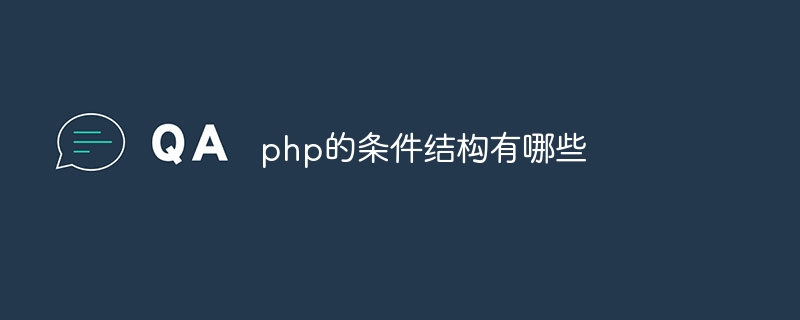
The conditional structures of PHP include if statements, if-else statements, if-elseif-else statements, switch statements, etc. Detailed introduction: 1. The if statement is one of the most basic conditional structures in PHP, allowing code blocks to be executed based on a condition; 2. the if-else statement is a conditional structure expanded on the basis of the if statement, allowing Execute one code block when the condition is true, and execute another code block when the condition is false; 3. if-elseif-else statements, etc.

The operating environment of this tutorial: Windows 10 system, PHP8.1.3 version, Dell G3 computer.
PHP is a programming language widely used in web development. It provides a variety of conditional structures so that developers can execute different code blocks according to different situations. In this article, we'll introduce common conditional constructs in PHP and explore their uses and syntax.
1. if statement:
The if statement is one of the most basic conditional structures in PHP. It allows us to execute a block of code based on a condition. The syntax of the if statement is as follows:
```
if (condition) {
// code to be executed if condition is true
}
```In this syntax, condition is a Boolean expression. If its value is true, the code block in the if statement is executed.
2. if-else statement:
The if-else statement is a conditional structure expanded on the basis of the if statement. It allows us to execute one block of code when the condition is true and another block of code when the condition is false. The syntax of the if-else statement is as follows:
```
if (condition) {
// code to be executed if condition is true
} else {
// code to be executed if condition is false
}
```In this syntax, if the value of condition is true, the code block in the if statement is executed; otherwise, the code block in the else statement is executed.
3. if-elseif-else statement:
The if-elseif-else statement is a conditional structure expanded on the basis of the if-else statement. It allows us to execute different blocks of code based on multiple conditions. The syntax of the if-elseif-else statement is as follows:
```
if (condition1) {
// code to be executed if condition1 is true
} elseif (condition2) {
// code to be executed if condition2 is true
} else {
// code to be executed if all conditions are false
}
```In this syntax, if the value of condition1 is true, the first code block is executed; if the value of condition1 is false, but the value of condition2 is true , execute the second code block; otherwise, execute the code block in the else statement.
4. Switch statement:
The switch statement is a conditional structure that executes different code blocks based on different conditions. It is similar to the if-elseif-else statement, but is more suitable for situations with multiple conditions. The syntax of the switch statement is as follows:
```
switch (expression) {
case value1:
// code to be executed if expression equals value1
break;
case value2:
// code to be executed if expression equals value2
break;
default:
// code to be executed if expression doesn't match any case
break;
}
```In this syntax, expression is an expression whose value will be compared with the value in each case statement. If the value of expression is equal to the value in a case statement, the corresponding code block is executed. If the value of expression is not equal to the values in all case statements, the code block in the default statement is executed.
Summary:
PHP provides a variety of conditional structures, including if statements, if-else statements, if-elseif-else statements and switch statements. These conditional structures allow developers to execute different code blocks based on different conditions, thereby achieving a more flexible program control flow. Proficient in the usage and syntax of these conditional structures will help developers write more efficient and readable PHP code.
The above is the detailed content of What are the conditional structures of php. For more information, please follow other related articles on the PHP Chinese website!